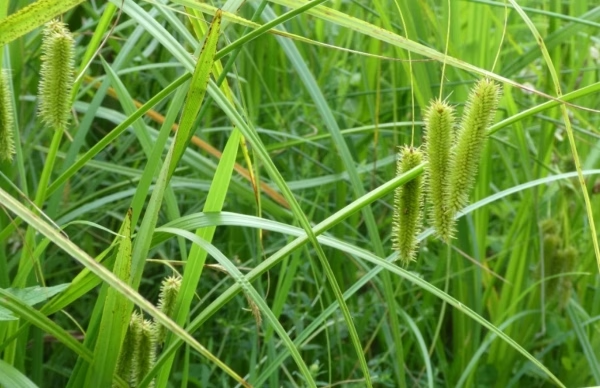
Sedges
Botanical Name
:
Varies by species, common genera include Carex and Cyperus.
Plant Type
:
Perennial grass-like plants (though not true grasses, they belong to the Cyperaceae family).
Seasons
:
Year-round (evergreen or semi-evergreen, depending on species and climate)
Sun Level
:
Full sun to full shade (varies by species)
Soil Type
:
Moist, well-draining soil, some species tolerate wet or boggy conditions, while others prefer drier soils.
Germination
:
Propagates through division, seeds, or rhizomes. Seeds may take several weeks to germinate.
P.H. Level
:
Slightly acidic to neutral (5.5–7.0)
Water/Irrigation
:
Many sedges require consistent moisture levels, especially those found in wetland habitats. However, some species are more drought-tolerant than others.
Fertilization
:
Not necessary unless using organic fertilizers to maintain soil richness.
Habit
:
Clumping, spreading, or arching, depending on the species.
Final Plant Height
:
6–36 inches (15–90 cm), depending on variety.
Spread
:
12–36 inches (30–90 cm)
Spacing
:
12–18 inches apart for ground cover; wider for specimen planting. Spacing should allow enough room for spreading without overcrowding—about the same width as its mature spread.
Flowers
:
Typically greenish-yellowish spikes borne on stalks above foliage. They have separate male and female flowers within spikelets.
Attracts
:
Some species attract pollinators; birds may eat the seeds.
Uses
:
Ground cover, erosion control, rain gardens, borders, container planting, wetland restoration.
Companions
:
Hostas, ferns, astilbes, coral bells, woodland perennials
Pruning
:
Cut back dead or tattered foliage in late winter or early spring.
Toxicity
:
Non-toxic to humans and pets
Pests
:
Generally pest-free but may attract aphids or grasshoppers.
Diseases
:
Rarely affected by disease, though root rot may occur in overly wet conditions.
Fun Fact
:
Unlike true grasses, sedges have triangular stems—a key feature captured in the phrase “Sedges have edges.”
Additional Info
:
With over 2,000 species worldwide, sedges can be found in diverse habitats, from woodlands to wetlands to alpine regions.
Botanical Name
:
Varies by species, common genera include Carex and Cyperus.
Plant Type
:
Perennial grass-like plants (though not true grasses, they belong to the Cyperaceae family).
Seasons
:
Year-round (evergreen or semi-evergreen, depending on species and climate)
Sun Level
:
Full sun to full shade (varies by species)
Soil Type
:
Moist, well-draining soil, some species tolerate wet or boggy conditions, while others prefer drier soils.
Germination
:
Propagates through division, seeds, or rhizomes. Seeds may take several weeks to germinate.
P.H. Level
:
Slightly acidic to neutral (5.5–7.0)
Water/Irrigation
:
Many sedges require consistent moisture levels, especially those found in wetland habitats. However, some species are more drought-tolerant than others.
Fertilization
:
Not necessary unless using organic fertilizers to maintain soil richness.
Habit
:
Clumping, spreading, or arching, depending on the species.
Final Plant Height
:
6–36 inches (15–90 cm), depending on variety.
Spread
:
12–36 inches (30–90 cm)
Spacing
:
12–18 inches apart for ground cover; wider for specimen planting. Spacing should allow enough room for spreading without overcrowding—about the same width as its mature spread.
Flowers
:
Typically greenish-yellowish spikes borne on stalks above foliage. They have separate male and female flowers within spikelets.
Attracts
:
Some species attract pollinators; birds may eat the seeds.
Uses
:
Ground cover, erosion control, rain gardens, borders, container planting, wetland restoration.
Companions
:
Hostas, ferns, astilbes, coral bells, woodland perennials
Pruning
:
Cut back dead or tattered foliage in late winter or early spring.
Toxicity
:
Non-toxic to humans and pets
Pests
:
Generally pest-free but may attract aphids or grasshoppers.
Diseases
:
Rarely affected by disease, though root rot may occur in overly wet conditions.
Fun Fact
:
Unlike true grasses, sedges have triangular stems—a key feature captured in the phrase “Sedges have edges.”
Additional Info
:
With over 2,000 species worldwide, sedges can be found in diverse habitats, from woodlands to wetlands to alpine regions.
Written by Salome Wapukha – https://www.linkedin.com/in/salome-wapukha-556700193/

